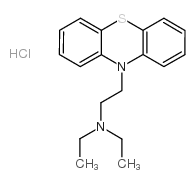diethazine hydrochloride
Modify Date: 2025-08-26 12:19:34

diethazine hydrochloride structure
|
Common Name | diethazine hydrochloride | ||
|---|---|---|---|---|
| CAS Number | 341-70-8 | Molecular Weight | 334.90700 | |
| Density | N/A | Boiling Point | 422.2ºC at 760 mmHg | |
| Molecular Formula | C18H23ClN2S | Melting Point | N/A | |
| MSDS | N/A | Flash Point | 209.1ºC | |
| Name | N,N-diethyl-2-phenothiazin-10-ylethanamine,hydrochloride |
|---|---|
| Synonym | More Synonyms |
| Boiling Point | 422.2ºC at 760 mmHg |
|---|---|
| Molecular Formula | C18H23ClN2S |
| Molecular Weight | 334.90700 |
| Flash Point | 209.1ºC |
| Exact Mass | 334.12700 |
| PSA | 31.78000 |
| LogP | 5.49810 |
CHEMICAL IDENTIFICATION
HEALTH HAZARD DATAACUTE TOXICITY DATA
MUTATION DATA
|
| HS Code | 2934300000 |
|---|
| HS Code | 2934300000 |
|---|---|
| Summary | 2934300000. other compounds containing in the structure a phenothiazine ring-system (whether or not hydrogenated), not further fused. VAT:17.0%. Tax rebate rate:13.0%. . MFN tariff:6.5%. General tariff:20.0% |
| diethyl-(2-phenothiazin-10-yl-ethyl)-amine,monohydrochloride |
| Deparkin |
| diethyl-(2-phenothiazin-10-yl-ethyl)-amine,hydrochloride |
| Antipar |
| Diethazine hydrochloride |
| Diethazinhydrochlorid |
| Dinezin |
| Diparcol |
| Aparkazin |
| Thiantan |
| 10-[2-(diethylamino)ethyl]phenothiazine hydrochloride |
| Thiontan |
| Dinezine |
| Latibon |